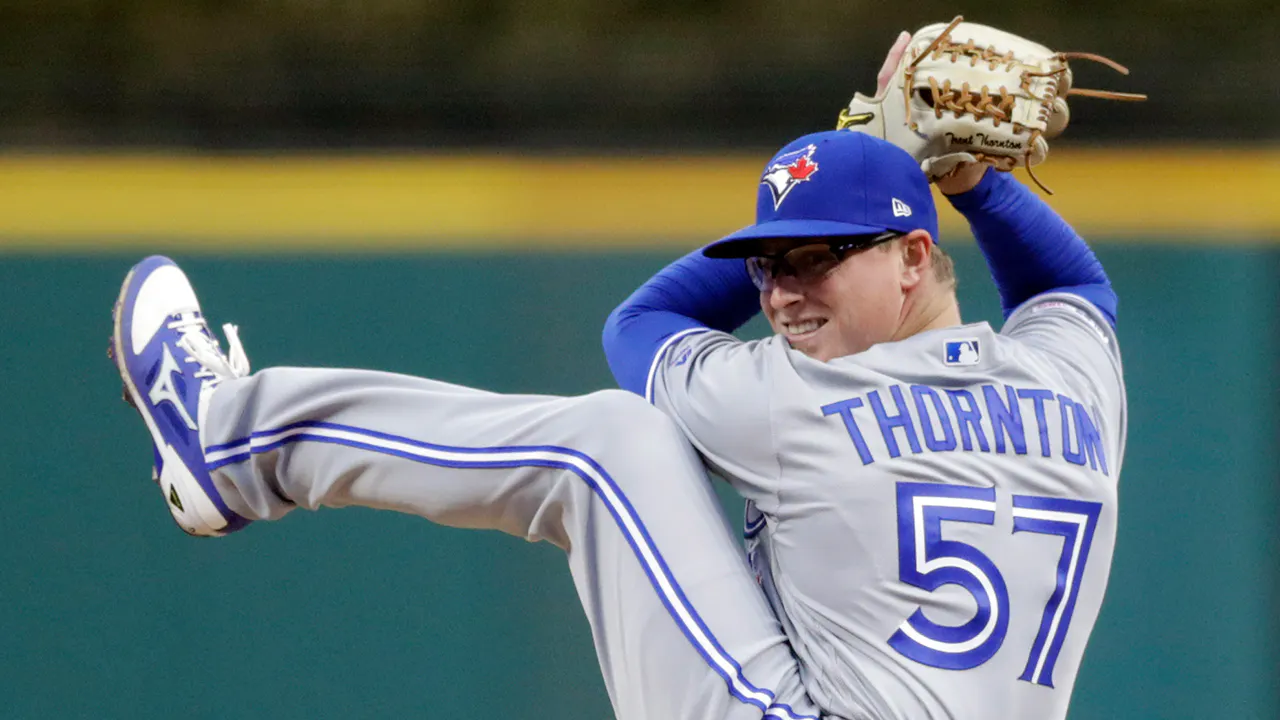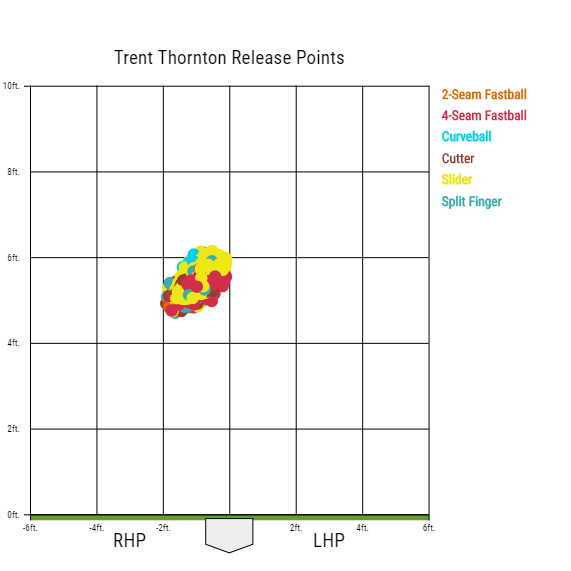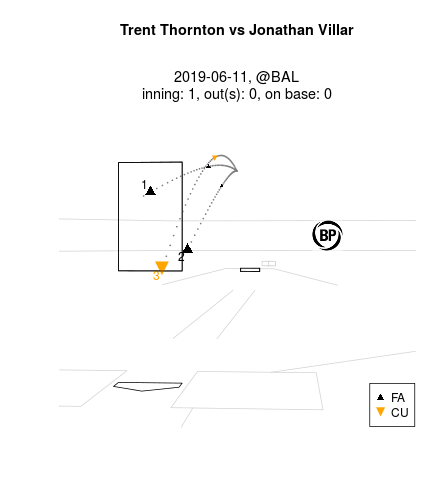Trent Thornton and taking the next step

Trent Thornton was announced this week as the Blue Jays fourth starter. He was the Blue Jays only reliable starter last season, throwing 154.1 innings over 29 starts. The results were a mixed bag with a 4.84 ERA, 4.59 FIP and 4.94xFIP.
Thornton has a bit of a funky delivery which made repeating his mechanics difficult and caused inconsistencies in his release point.

No pitcher is going to have a perfect release point every time, but Thorton’s range here is a lot larger than most pitchers. For comparison here are a few Blue Jays right-handers: Chase Anderson, Sam Gaviglio, Tanner Roark.
No one is going to release the ball from the exact same spot every time. You can see with each of these pitchers there is variance but none of them have the same vertical range that Thornton does.
This inconsistency has caused a problem for Thorton as he is essentially tipping his pitches.
Look at Thornton’s release points again. There is plenty of yellow and blue near the top, indicating breaking ball and pink much lower for the fastball. It’s a subtle difference but one major league hitters can certainly pick up. The results speak for themselves. Batters had a 140 wRC+ against Thornton’s fastball.
It didn’t help that Thornton’s location on his fastball tended to be in the bottom half of the zone.

Batters took advantage and hit the fastball hard.

Thorntons’s four-seamer averages 92.9 mph and spins at 2373 rpm per Baseball Savant, giving him a Bauer Unit (RPM/MPH) of 25.5, which is above the MLB average of 24. This means that Thornton because he has slightly below average velocity but slightly above average spin, should be pitching up in the zone more.
Getting his fastball out of the heart of the plate is going to help Thornton significantly. What also could be of benefit for him is if he tunnelled his pitches better. Thornton throws an elite breaking ball. (Note Baseball Savant has Thornton throwing predominately a slider, while Fangraphs has him throwing a curve and a slider, for simplicity I am just going to describe the pitch as a breaking ball for this post).
Thorton’s breaking ball has a spin rate of 3089 RPM’s, making him one of the few pitchers to have a pitch with over 3000 RPM. Batters had a .258 wOBA against the pitch, per Fangraphs and had a double digit swinging strike rate. With a pitch this good it can be easy to say “well just throw that more and the fastball less.” It’s never that easy. Per Baseball Savant Thornton’s breaking ball drops 52.3 inches which is 8.9 inches more than similar pitchers. A pitch with that much drop can be hard to place in the strike zone. Thornton found the zone just over a third of the time.
Thornton needs his fastball to get strikes. Part of the problem for Thornton was his pitches didn’t work well off each other. In order to increase the effectiveness of his arsenal he needs to tunnel his pitches better.
For a good intro into pitch tunnelling, and for definitions of the pitch tunnelling terms, check out this article from Pitcher List.
Baseball Prospectus has pitch tunnelling stats on their website and with that we can see how Thornton fares.
| Thornton | MLB Average | |
| Release Distance | 3.81 inches | 2.6 |
| Pre-tunnel Max(imum Distance) | 1.45 inches | 1.54 |
| Pre-tunnel Max Time | 0.171 seconds | 0.169 |
| Plate Distance | 18.9 inches | 18.2 |
| Flight Time | 0.0282 seconds | 0.026 |
| Plate PreMax Ratio | 13.0 | 11.9 |
There are a lot of numbers and terms here, so I am only going to talk about a few of them. If you do want more of an explanation, check out that Pitcher List article and Baseball Prospectus.
Release Distance – As we saw in the graph from the beginning Thornton’s release point varies a lot. 3.81 inches was one of the largest ranges in the league.
Pre-tunnel Max Time – This tells us how quickly two pitchers separate in flight. The larger the number the more time remaining the ball has before it reaches the plate. This will always be greater than 0.150 (or 150 milliseconds), the closer the number is to 0.150 the later the pitches separate. For Thornton that number of 0.171 is well above 0.150 indicating his pitches separate very quickly.
Plate Distance – How far apart back to back pitches are at home plate. Thorton’s 18.9 inches is basically right at the average. So he does a fine job at putting back to back pitches in the same area of the plate.
Using Baseball Prospectus’ Interactive Matchup Tool, we can get a visual of what these numbers mean.

This is Thornton pitching against Jonathan Villar. The pitches all appear to start from a similar release point, but immediately go in different directions. Pitch two and three end up in similar spots on the plate but their path to that spot couldn’t be different. The curveball comes out of his hand and immediately goes up; it’s never on the same path as his fastball. As a batter this can be easy to pick up and lay off of the breaking ball and wait for a fastball in the zone.
When looking at individual combinations of pitches this becomes very clear.
| Pitch Sequence | Batter | Total | 1st Pitch Type | 2nd Pitch Type | RelDist | PreMaxTime | PlateDist |
| FA|SL | R | 113 | FA | SL | 5.91 | 0.157 | 26.04 |
| SL|FA | R | 96 | SL | FA | 6.36 | 0.223 | 25.54 |
| CU|FA | L | 90 | CU | FA | 5.41 | 0.226 | 24.31 |
| FA|CU | L | 85 | FA | CU | 5.98 | 0.157 | 23.46 |
| SL|SL | R | 73 | SL | SL | 1.72 | 0.158 | 16.24 |
This is Thornton’s most commonly used pairs of pitches involving his slider or curve. The best combination here is slider/slider to a right-handed batter. His PreMaxTime is good when he throws a fastball then the curve or slider, meaning they stay on the same plane for longer; however they are released at such different points. It’s close to a six inch release difference which is substantial. This is what we see above in the Villar at bat. Thornton’s fastball and breaking ball might follow the same plane but the curve is realised from such a higher angle there is no benefit.
Trent Thornton comes into this shortened season as the Blue Jays fourth starter. He had a long off-season where hopefully he was able to gain some consistency in his mechanics. This would help him improve his pitch tunnelling and allow him to take advantage of his great breaking ball. We will find out soon enough what changes he did make, and if he can maximize his potential and be a big contributor to a successful Blue Jays team.
Recent articles from Paul Berthelot





